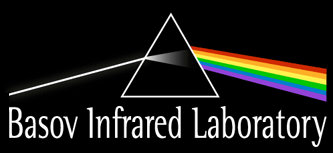Machine Learning from Advanced Nano-Optical Imaging
The scattering-type scanning near-field optical microscopy(s-SNOM) technique has recently spread to many research areas and enabled notable discoveries in the field of quantum materials, extraterrestrial particles, catalytic substances, and biological samples. Various forms of nano-optical measurement, such as monochromatic nano-imaging, broadband nano-spectroscopy, time-resolved pump-probe spectroscopy and hyperspectral imaging produce terabytes of image-like, spectrum-like and higher dimensional data in a daily basis. In our group, we apply and develop advanced Machine learning algorithm for faster data acquisition, more quantitative data interpretation and automated data collection for s-SNOM. With the assistance of AI- and ML-enhanced data acquisition and analysis, scanning probe optical nanosopy is poised to become more efficient, accurate and intelligent.
In collaboration with Mengkun Liu (Stony Brook University)
Recent review articles: Refs. 332
Recent results:
Accelerated Nano-Optical Imaging through Sparse Sampling
Fu et al. Nano Letters, 24, 2149 (2024). Ref [355]
Details
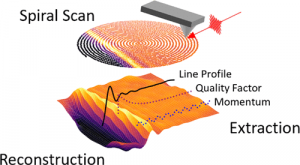 The integration time and signal-to-noise ratio are inextricably linked when performing scanning probe microscopy based on raster scanning. This often yields a large lower bound on the measurement time, for example, in nano-optical imaging experiments performed using a scanning near-field optical microscope (SNOM). Here, we utilize sparse scanning augmented with Gaussian process regression to bypass the time constraint. We apply this approach to image charge-transfer polaritons in graphene residing on ruthenium trichloride (α-RuCl3) and obtain key features such as polariton damping and dispersion. Critically, nano-optical SNOM imaging data obtained via sparse sampling are in good agreement with those extracted from traditional raster scans but require 11 times fewer sampled points. As a result, Gaussian process-aided sparse spiral scans offer a major decrease in scanning time.
The integration time and signal-to-noise ratio are inextricably linked when performing scanning probe microscopy based on raster scanning. This often yields a large lower bound on the measurement time, for example, in nano-optical imaging experiments performed using a scanning near-field optical microscope (SNOM). Here, we utilize sparse scanning augmented with Gaussian process regression to bypass the time constraint. We apply this approach to image charge-transfer polaritons in graphene residing on ruthenium trichloride (α-RuCl3) and obtain key features such as polariton damping and dispersion. Critically, nano-optical SNOM imaging data obtained via sparse sampling are in good agreement with those extracted from traditional raster scans but require 11 times fewer sampled points. As a result, Gaussian process-aided sparse spiral scans offer a major decrease in scanning time.
Machine Learning for Optical Scanning Probe Nanoscopy
Chen, Xu et al. Advanced Material, 2022, 2109171 (2022). Ref [332]
Details
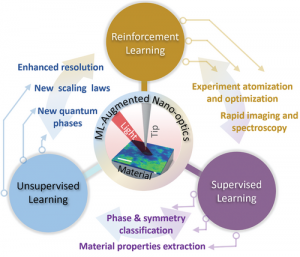 The ability to perform nanometer-scale optical imaging and spectroscopy is key to deciphering the low-energy effects in quantum materials, as well as vibrational fingerprints in planetary and extraterrestrial particles, catalytic substances, and aqueous biological samples. These tasks can be accomplished by the scattering-type scanning near-field optical microscopy (s-SNOM) technique that has recently spread to many research fields and enabled notable discoveries. Herein, it is shown that the s-SNOM, together with scanning probe research in general, can benefit in many ways from artificial-intelligence (AI) and machine-learning (ML) algorithms. Augmented with AI- and ML-enhanced data acquisition and analysis, scanning probe optical nanoscopy is poised to become more efficient, accurate, and intelligent.
The ability to perform nanometer-scale optical imaging and spectroscopy is key to deciphering the low-energy effects in quantum materials, as well as vibrational fingerprints in planetary and extraterrestrial particles, catalytic substances, and aqueous biological samples. These tasks can be accomplished by the scattering-type scanning near-field optical microscopy (s-SNOM) technique that has recently spread to many research fields and enabled notable discoveries. Herein, it is shown that the s-SNOM, together with scanning probe research in general, can benefit in many ways from artificial-intelligence (AI) and machine-learning (ML) algorithms. Augmented with AI- and ML-enhanced data acquisition and analysis, scanning probe optical nanoscopy is poised to become more efficient, accurate, and intelligent.
Deep Learning Analysis of Polaritonic Wave Images
Xu et al. Acs Nano, 15, 18182 (2021). Ref. [317]
Details
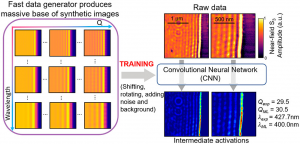 Scattering-type scanning near-field optical microscope(s-SNOM) can excite and probe propagating modes (plasmon polariton, phonon polariton, exciton polariton, etc.) in the quantum materials. By extracting the wavelengths and the quality factors of the propagating modes, one can infer the local optical and electronic properties. The traditional analysis of polaritonic images requires intensive manual processing and fitting of the interference pattern. In this work, we showed that the convolutional neural network (CNN) enables regression on images in a time scale that is at least 3 orders of magnitude faster than common fitting/processing procedures. This protocol can also be adapted to other scanning probe microscopies dataset and applied for parameter extractions on more complicated nano-scale features.
Scattering-type scanning near-field optical microscope(s-SNOM) can excite and probe propagating modes (plasmon polariton, phonon polariton, exciton polariton, etc.) in the quantum materials. By extracting the wavelengths and the quality factors of the propagating modes, one can infer the local optical and electronic properties. The traditional analysis of polaritonic images requires intensive manual processing and fitting of the interference pattern. In this work, we showed that the convolutional neural network (CNN) enables regression on images in a time scale that is at least 3 orders of magnitude faster than common fitting/processing procedures. This protocol can also be adapted to other scanning probe microscopies dataset and applied for parameter extractions on more complicated nano-scale features.
Hybrid Machine Learning for Scanning Near-Field Optical Spectroscopy
Chen et al. Acs Photonics 8, 2987 (2021). Ref. [312]
Details
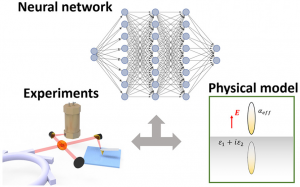 In the scanning probe microscopy techniques, the local optical properties of samples are probed by measuring the scattering signal from the tip. However, the tip-sample electromagnetic interaction is non-trivial, and it is always a challenge to get an analytical and accurate model without approximation. As a powerful tool to establish complex correlation between data, the artificial neural network (ANN) is proved to be an alternative approach for understanding the tip-sample interaction and provide a one-to-one correspondence between scattering signal and the local optical conductivity. In this work, we also show that the physics-infused hybrid neural network, enabled by training dataset combined with both modeled data and experimental data, can predict the tip the probe-sample interaction with better accuracy and generalization.
In the scanning probe microscopy techniques, the local optical properties of samples are probed by measuring the scattering signal from the tip. However, the tip-sample electromagnetic interaction is non-trivial, and it is always a challenge to get an analytical and accurate model without approximation. As a powerful tool to establish complex correlation between data, the artificial neural network (ANN) is proved to be an alternative approach for understanding the tip-sample interaction and provide a one-to-one correspondence between scattering signal and the local optical conductivity. In this work, we also show that the physics-infused hybrid neural network, enabled by training dataset combined with both modeled data and experimental data, can predict the tip the probe-sample interaction with better accuracy and generalization.

